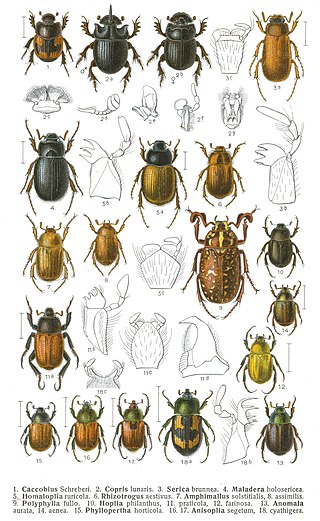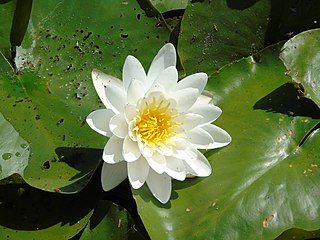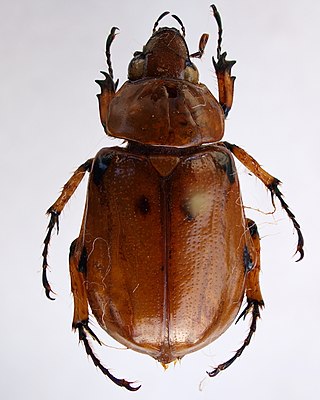
The family Scarabaeidae, as currently defined, consists of over 35,000 species of beetles worldwide; they are often called scarabs or scarab beetles. The classification of this family has undergone significant change. Several groups formerly treated as subfamilies have been elevated to family rank, and some reduced to lower ranks. The subfamilies listed in this article are in accordance with those in Catalog of Life (2023).

Nymphaea is a genus of hardy and tender aquatic plants in the family Nymphaeaceae. The genus has a cosmopolitan distribution. Many species are cultivated as ornamental plants, and many cultivars have been bred. Some taxa occur as introduced species where they are not native, and some are weeds. Plants of the genus are known commonly as water lilies, or waterlilies in the United Kingdom. The genus name is from the Greek νυμφαία, nymphaia and the Latin nymphaea, which means "water lily" and were inspired by the nymphs of Greek and Latin mythology.

Dynastinae or rhinoceros beetles are a subfamily of the scarab beetle family (Scarabaeidae). Other common names – some for particular groups of rhinoceros beetles – include Hercules beetles, unicorn beetles or horn beetles. Over 1,500 species and 225 genera of rhinoceros beetles are known.

Tomarus is a genus of scarab beetles in the subfamily Dynastinae, the rhinoceros beetles. They are native to the Americas, where they are distributed from the central United States to Argentina, and a few species occur in the Caribbean.

Cyclocephala castanea is a species of small beetle in the family Scarabaeidae which is native to the Amazon basin in South America. This beetle and certain others in the same genus have a commensal relationship with the large water lily Victoria amazonica. Visiting the flower for food, the beetles are trapped inside and emerge laden with pollen the following evening.
Cyclocephala nodanotherwon is a species of rhinoceros beetle in the scarab family. It has only been found in Amazonas, Brazil. Brett C. Ratcliffe described and named the species in 1992.

Cyclocephalini is a tribe of scarab beetles in the family Scarabaeidae.

Macrodactylini is a tribe of May beetles and junebugs in the family Scarabaeidae. There are at least 46 genera and over a thousand species described in the tribe Macrodactylini.
Leptohoplia is a genus of shining leaf chafers in the family of beetles known as Scarabaeidae. There are at least two described species in Leptohoplia.

Ancognatha is a genus of rhinoceros beetles in the family Scarabaeidae. There are more than 20 described species in Ancognatha.
Gymnetina is a genus of fruit and flower chafers in the family of beetles known as Scarabaeidae. There are about six described species in Gymnetina.

Chrysina woodi, or Wood's jewel scarab, is a species of shining leaf chafer in the family of beetles known as Scarabaeidae. This bright green beetle is native to Chihuahua in Mexico, and New Mexico and Texas in the United States. This beetle is 25–35 mm (1.0–1.4 in) long and it resembles C. beyeri, but that species has all blue-purple legs and tarsi.
Mallophora ruficauda is a species of parasitic robber fly in the family Asilidae, endemic to South and Central America. Like other robber flies, M. ruficauda is known for its aggressive behavior and predation upon other insects, especially bees. M. ruficauda mimics a bumblebee to fool predators into thinking it has a painful sting and is not worth eating.

Nymphaea gardneriana is a species of waterlily native to Cuba and tropical South America.

Nymphaea paganuccii is a species of waterlily endemic to Brazil.

Nymphaea lasiophylla is a species of waterlily native to East Brazil. It has also been introduced to the Venezuelan Antilles.
Nymphaea pedersenii is a species of waterlily native to Argentina, Bolivia, Brazil, and Uruguay.
Nymphaea lingulata is a species of waterlily native to Bolivia, Brazil, and Paraguay.

Nymphaea subg. Hydrocallis is a subgenus of the genus Nymphaea.

Nymphaea subg. Lotos is a subgenus of the genus Nymphaea.















